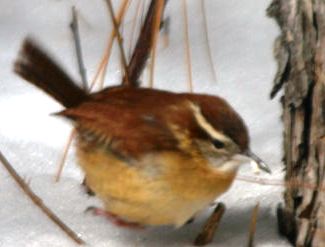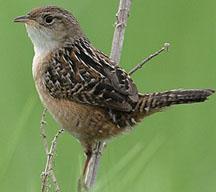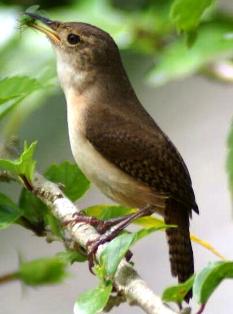Discover Florida Nature
It's time to explore the natural Florida


|
|
|
|
|
 Carolina
Wren- The Carolina wren is an adaptable dweller of forestlands,
swamps, farms, and tree-filled human communities. The state bird of
South Carolina, Carolina wrens are medium sized wrens with dark brown
upperparts and buff underparts. Eyebrows are vivid white. The Carolina
wren's throat is white and it's bill is long and decurved. Wings and
tail are dark barred with white flecks. Both sexes of the Carolina wren
are similar. The Carolina Wren uses the skin of snakes, hair, feathers
and many other materials to build their dome-shaped nests. Singing one
of the loudest songs per volume of bird, the Carolina Wren's
"tea-kettle, tea-kettle, tea-kettle" is familiar across the Southeast.
Unlike other wren species in its genus, only the male Carolina Wren
sings the loud song. It is a common bird in urban areas, and is more
likely to nest in a hanging plant than in a birdhouse. A pair bond may
form between a male and a female Carolina wren at any time of the year,
and the pair will stay together for life. Members of a pair stay
together on their territory year-round, and forage and move around the
territory together. Carolina
Wren- The Carolina wren is an adaptable dweller of forestlands,
swamps, farms, and tree-filled human communities. The state bird of
South Carolina, Carolina wrens are medium sized wrens with dark brown
upperparts and buff underparts. Eyebrows are vivid white. The Carolina
wren's throat is white and it's bill is long and decurved. Wings and
tail are dark barred with white flecks. Both sexes of the Carolina wren
are similar. The Carolina Wren uses the skin of snakes, hair, feathers
and many other materials to build their dome-shaped nests. Singing one
of the loudest songs per volume of bird, the Carolina Wren's
"tea-kettle, tea-kettle, tea-kettle" is familiar across the Southeast.
Unlike other wren species in its genus, only the male Carolina Wren
sings the loud song. It is a common bird in urban areas, and is more
likely to nest in a hanging plant than in a birdhouse. A pair bond may
form between a male and a female Carolina wren at any time of the year,
and the pair will stay together for life. Members of a pair stay
together on their territory year-round, and forage and move around the
territory together.  Sedge
Wren- The Sedge Wren is a tiny, secretive wren of grassy
marshes. This wren is Buff-colored, with finely streaked crown and back.
The sedge wren has pale brown eyebrows, a short barred tail,, short bill
and the legs and feet are pink. One of the most nomadic territorial
birds. In any area it may be abundant one year, absent the next. Best
distinguished by voice and habitat, the sedge wren is most often seen as
it is flushed from grass and flies off, only to drop from view a few
feet away. Sedge wrens have a distinctive flight, their wings vibrate
stiffly as the bird seems to float over the ground. This wren nests in
dense tall sedges and grasses in wet meadows, hayfields, and marshes.
Like other wrens, it builds "dummy" nests, often hidden in dense marsh
grass. The sedge wren is also known as the Short-billed Marsh Wren and
the Grass Wren. There are about 20 different subspecies which are found
across most of the Americas. Some of these forms may be separate
species. A group of wrens has many collective nouns, including a
"chime", "flight", "flock", and "herd" of wrens. Sedge
Wren- The Sedge Wren is a tiny, secretive wren of grassy
marshes. This wren is Buff-colored, with finely streaked crown and back.
The sedge wren has pale brown eyebrows, a short barred tail,, short bill
and the legs and feet are pink. One of the most nomadic territorial
birds. In any area it may be abundant one year, absent the next. Best
distinguished by voice and habitat, the sedge wren is most often seen as
it is flushed from grass and flies off, only to drop from view a few
feet away. Sedge wrens have a distinctive flight, their wings vibrate
stiffly as the bird seems to float over the ground. This wren nests in
dense tall sedges and grasses in wet meadows, hayfields, and marshes.
Like other wrens, it builds "dummy" nests, often hidden in dense marsh
grass. The sedge wren is also known as the Short-billed Marsh Wren and
the Grass Wren. There are about 20 different subspecies which are found
across most of the Americas. Some of these forms may be separate
species. A group of wrens has many collective nouns, including a
"chime", "flight", "flock", and "herd" of wrens. House
Wren-
The house wren often nests in odd places such as mailboxes, flowerpots,
and even the pockets of coats on clotheslines. When competing for a nest
site, the House Wren may throw out the nest, eggs, and even the young of
other hole-breeding birds. In the process this bird may kill its
competitors, or if they are more powerful, it harasses them by filling
the hole with its own nest material. If House Wrens return in spring to
find an old nest still in place, they usually remove it stick by stick,
then proceed to rebuild, often using the very material they've just
discarded. Outside the breeding season, House Wrens are shy and much
less in evidence than when they are singing during the breeding season.
The house wren is a tiny bird with a short tail, often held cocked over
the back. This wren is dusky brown above, paler below, and has no
distinctive markings. House wrens are usually 11 to 13 cm long and weigh
10 to 12 g. Males and females are identical in coloration, but males are
slightly larger in some traits. House wrens breed between late April and
early September, with the majority of clutches started in mid-late May.
The males are the first to return from migration and establish territory
for nesting within a few hours/days of arrival. The females return in
time to complete the nest after choosing a male. House
Wren-
The house wren often nests in odd places such as mailboxes, flowerpots,
and even the pockets of coats on clotheslines. When competing for a nest
site, the House Wren may throw out the nest, eggs, and even the young of
other hole-breeding birds. In the process this bird may kill its
competitors, or if they are more powerful, it harasses them by filling
the hole with its own nest material. If House Wrens return in spring to
find an old nest still in place, they usually remove it stick by stick,
then proceed to rebuild, often using the very material they've just
discarded. Outside the breeding season, House Wrens are shy and much
less in evidence than when they are singing during the breeding season.
The house wren is a tiny bird with a short tail, often held cocked over
the back. This wren is dusky brown above, paler below, and has no
distinctive markings. House wrens are usually 11 to 13 cm long and weigh
10 to 12 g. Males and females are identical in coloration, but males are
slightly larger in some traits. House wrens breed between late April and
early September, with the majority of clutches started in mid-late May.
The males are the first to return from migration and establish territory
for nesting within a few hours/days of arrival. The females return in
time to complete the nest after choosing a male. Chimney
Swift-
A "flying cigar," the Chimney Swift is rarely seen perched. Its
high-pitched twittering is a familiar sound during summertime in the
city as it flies high above, catching small flying insects. Unable to
perch or stand upright as songbirds do, chimney swifts are uniquely
equipped to roost clinging to vertical surfaces. Their small but strong
feet are tipped with four sharp claws which act as grappling hooks to
hold them firmly to their roost. Their tail feather shafts extend as
stiff exposed spines to provide additional support for their vertical
lifestyle. Swifts are among the most aerial of birds, flying almost
constantly except when at the nest or roosting at night. The Chimney
Swift bathes in flight, gliding down to water, smacking the surface with
its breast, then bouncing up and shaking the water from its plumage as
it flies away. All swallows have longer tails, usually with a notch or
fork, and broader wings. Black Swift and White-throated Swift have
forked tails and different patterning below. Chimney
Swift-
A "flying cigar," the Chimney Swift is rarely seen perched. Its
high-pitched twittering is a familiar sound during summertime in the
city as it flies high above, catching small flying insects. Unable to
perch or stand upright as songbirds do, chimney swifts are uniquely
equipped to roost clinging to vertical surfaces. Their small but strong
feet are tipped with four sharp claws which act as grappling hooks to
hold them firmly to their roost. Their tail feather shafts extend as
stiff exposed spines to provide additional support for their vertical
lifestyle. Swifts are among the most aerial of birds, flying almost
constantly except when at the nest or roosting at night. The Chimney
Swift bathes in flight, gliding down to water, smacking the surface with
its breast, then bouncing up and shaking the water from its plumage as
it flies away. All swallows have longer tails, usually with a notch or
fork, and broader wings. Black Swift and White-throated Swift have
forked tails and different patterning below.
|
|
|
Advertise | Privacy Statement | Dog Encyclopedia | Video |Contact | Alaska Nature |
|